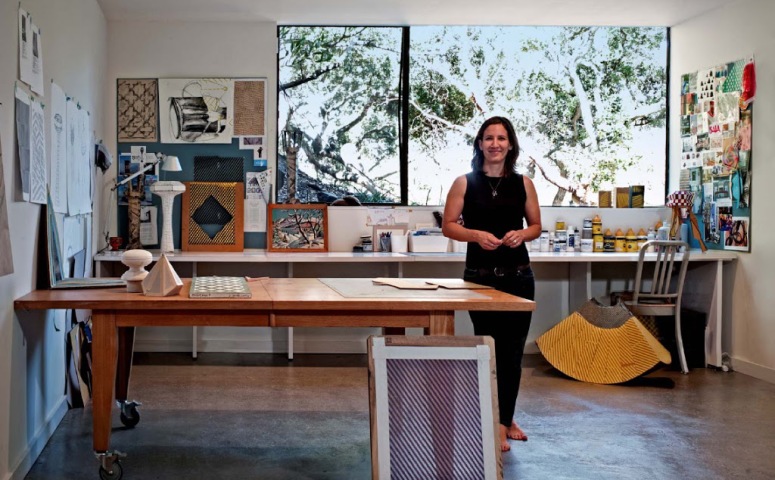This morning Verda Alexander and her husband Primo Orpilla were named Designers of the Year by Contract magazine. They have ridden a few technology waves providing office spaces for all kinds of high tech companies. Their work often has a surprising edge, whether it is a form, a color, a mural. Part of that edge comes from Verda’s personal explorations as an artist. She moves between the functional and the aesthetic all the time. I thought it would be interesting to find out more about her work.
Q: What did you study in school?
I got a Bachelors in art, then a Masters in landscape architecture. After several years of practicing interior design I went back and got an MFA.
Q: Can you recount some of that process?
When I got my bachelors my heroes were artists like Michael Heizer, Robert Irwin, and Mary Miss. I was interested in earthwork artists and artists who engaged the public. I liked how Mary Miss used plywood and made these great geometric shapes in the landscape.
I thought that the way to follow that interest was to get an architecture or a landscape architecture degree. The portfolio I submitted for graduate school was all art projects that I had done at San Jose State. Then I got my landscape architecture degree, and it seemed like I’d gotten even further away from the art thing, because once you go down the practical and professional path you aren’t seen as an artist.
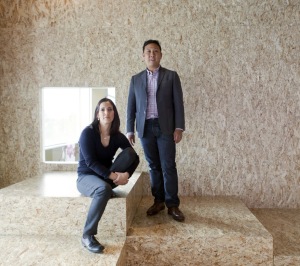 |
| Verda with her husband and partner Primo Photo: Jasper Sanidad |
Q: Can you tell me more about that professional path?
The priority was starting and growing our business. That took most of my time for close to ten years. When the dot com bomb happened, I found myself with some extra time and thought, all right, seize the moment. So I went back for my masters in fine art at the San Francisco Art Institute.
Before that I was doing art on my own. When I was travelling I would be sketching nature, and then I started doing these little pattern drawings of the leaf patterns and repeating them. I was looking for pattern in the environment or some sort of motif that’s taken from nature and used architecturally.
Q: Did you decide to reverse your emphasis and make art the more significant practice and have the design work be less important? Or were they influencing each other?
They were influencing each other, but I didn’t realize that they were. At first I wanted them to very be separate. But after getting my MFA, I thought, well, at some point it would be great if they did come together. For example, I could design patterns for a carpet company. But there are very few who can blur the line between art and design like Jorge Pardo. I don’t know if I want to do that exactly, but it’s an interesting idea.
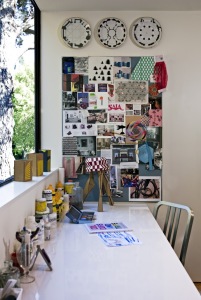 |
| Verda’s studio work surface Photo: Jasper Sanidad |
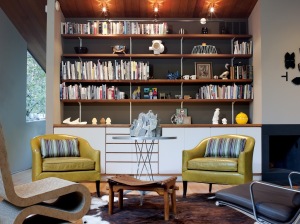 |
| Verda’s sculpture on table Photo: Jasper Sanidad |
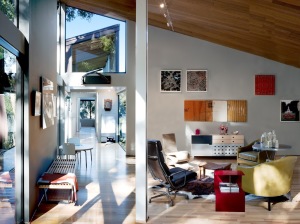 |
| The Orpilla/Alexander Living Room Photo: Jasper Sanidad |
Q: So talk about some of the things you started to explore when you were at the Art Institute.
My first projects had a lot to do with my landscape architecture — I guess studies would be the best way to put it, like thinking about notions of the picturesque and landscape architecture history and trying to incorporate those in my art.
I made a garden fountain that had a virtual component and a sound component. I was interested in playing around with, how you might create public art, but more subtle public art, where you’d be walking and you’d hear something or you’d see something in the landscape, but it was very subtle. I created a Mary garden.
Q: A merry garden?
A Mary garden, which is a medieval garden form type, a garden that’s based symbolically on the Virgin Mary.
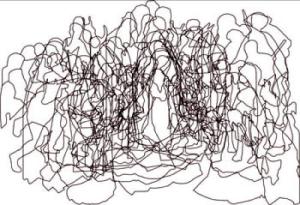 |
| Nativities Courtesy of verdaalexander.com |
Q: Where was this?
It was installed inside.
But I got frustrated, because it was like two layers — first of all, art is difficult to understand, and then you’ve got all this landscape history that nobody knows anything about at all.
So I took away the layers. What I found was that I was really interested in a lot of the forms, the architectural shapes and forms, motifs, and, again, pattern. Many of them remained consistent over time. I took those shapes or patterns or motifs and mutated them or abstracted them and then transformed them into some other form. You could tell what they were, but it was actually a completely new and almost, futuristic shape or motif.
Q: Can you give me some examples?
I took some medieval window moldings in profile and put them in a 3D architectural program and rotated them on the axis so they were 3D objects. And they were just bizarre. You couldn’t put a finger on exactly what they were. They could look like bombs and baby toys at the same time. But they started as an architectural feature from the Middle Ages and ended up looking quite futuristic.
I found that the idea of a picnic, which was probably a17th century idea, had several motifs to work with like the checkerboard cloth, and fleur de lys. I took it from a two-dimensional shape and made it three-dimensional installation. I was reimagining a flat still life.
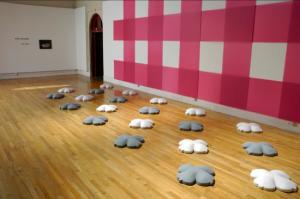 |
| The Picnic Installation Courtesy of verdaalexander.com |
 |
| Medieval Mouldings Installation View Courtesy of verdaalexander.com |
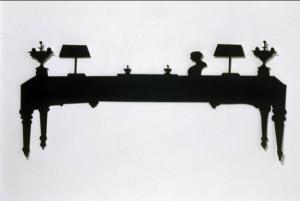 |
| Victoria’s Desk Courtesy of verdaalexander.com |
Q: And making the still life less still?
Yes. I love history, architectural history, and landscape architectural history. I took one of Thomas Jefferson’s round buildings and extruded it and turned it into an art piece.
Recently I have been working with more mundane things like hazard stripes and traffic stripes and turning those into sculpture. You can tell where it came from but again, you get something radically different.
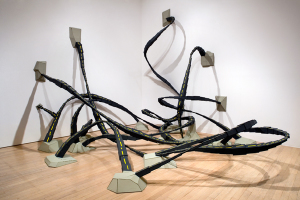 |
| Run A Way Courtesy of verdaalexander.com |
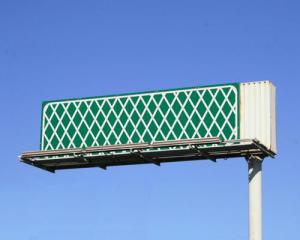 |
| Freeway Sign Courtesy of verdaalexander.com |
Q: First tell me about the project I saw on exhibit about Brittany. Architecture, interior design, and place seemed like significant influences there.
I was in Brittany for about two weeks, and I researched where people lived and how many of the homes were laid out in a similar manner.
Q: Were these fishermen’s homes? What century were they?
The 17th, 18th, and 19th centuries. And they hadn’t changed over the years, in a lot of cases. They belonged to average people.
Q: What was the project?
I recreated the logic system of the furnishings. I maneuvered to certain shapes – most if was furniture, including tables, beds, and wardrobes. They didn’t have chairs, they all sat on benches. I looked at every house plan and created volumetric sculptures. They had a modernist feel to them. But nobody got the historical component, which is fine.
Q: The origin may not matter.
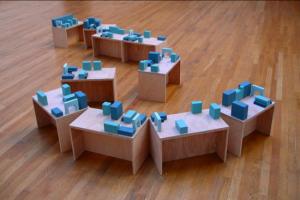 |
| Brittany Homes Courtesy of verdaalexander.com |
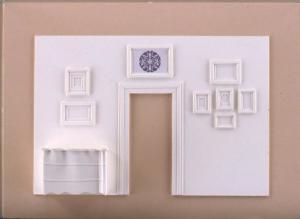 |
| Goethe’s House Courtesy of verdaalexander.com |
Q: Your more recent work seems to be about more contemporary American settlements. They are like puzzle pieces of city life.
I worked with the skyline you see at night. I did all kinds of abstractions of a building window grids. I silk-screened them onto a kind of stiff paper. I glued them into an assemblage sculpture. It’s called “Berg.”
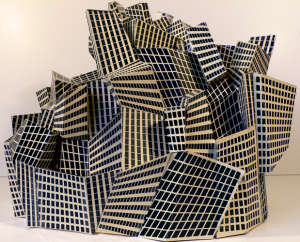 |
| Berg Courtesy of verdaalexander.com |
Q: Like a town in Europe?
And an iceberg, because it looks like a crazy city growing out of an iceberg. It also reminds me of ‘40s graphic novels.
I also love airports and all the markings. I’ve been playing with and studying airports and redrawing different airports. And what I ended up finally coming up with was taking the center stripe of a roadway and creating a logic system for how I’d construct these pieces. A box with an end, a telescoping kind of idea, but it’s rectangular, and just making them over and over again, and connecting them with the stripes so once it’s done, it’s trying to warp it to its extreme.
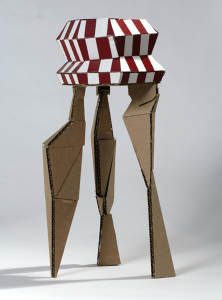 |
| Control Tower Courtesy of verdaalexander.com |
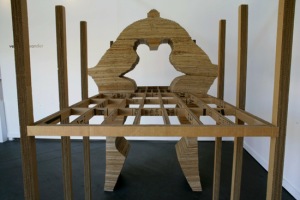 |
| Hut for Ro Cham Courtesy of verdaalexander.com |
Q: So you’re warping cardboard?
A box made out of cardboard.
I put them together and stencil on the stripe. And so it would go from big to small, to small to big. And I’d make them whatever lengths I wanted. And then I’d twist them and turn them and tweak them, and it became kind of this crazy, three-dimensional roadway system.
Q: Are you controlling the chaos?
No. The crazier the better. And really, the limitations are just the materials, and how much I could work and tweak them.
Q: How did you know when you were done?
Well, I might never have finished. It was whenever I ran out of time. So when I installed the piece at the San Jose Museum of Art, I just made them until my deadline, till I had to ship them over there. I had three days to install it, and I worked on it till I was out of time.
Q: So does it matter if you ever sell any of these?
No, because I have my day job, which most artists do.
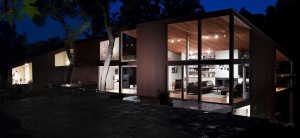 |
| Orpilla/Alexander Home Photo: Jasper Sanidad |
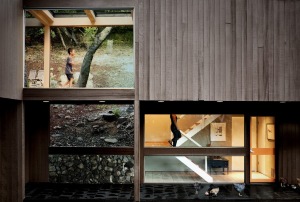 |
| The artist walks from her studio to her living quarters. Photo: Jasper Sanidad |
Q: Does that free you to then make something that doesn’t have to be marketed or commodified?
Yes. Or archival. One of the original runaways, that’s what I call the road pieces, broke in the heat. The glue melted on a hot day and it collapsed!
Q: How has your young son Apolo been influenced by your being an artist?
He has a very broad idea of what art might be; he never dismisses anything. Some of the best moments at the last Venice Biennale were with him. We had just left one of Scarpa’s buildings and we walked into this plaza where somebody left a bunch of toys to ride in a little group. They were fairly far apart from each other in this weird perfect circle, but Primo and I hadn’t noticed it. Apollo saw it and he was absolutely positive it was a work of art.
For more information:
www.verdaalexander.com
www.contractmagazine.com
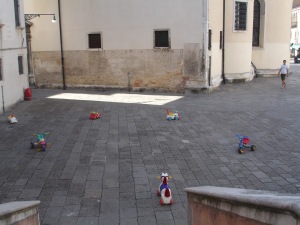 |
| The Toys in Venice |
